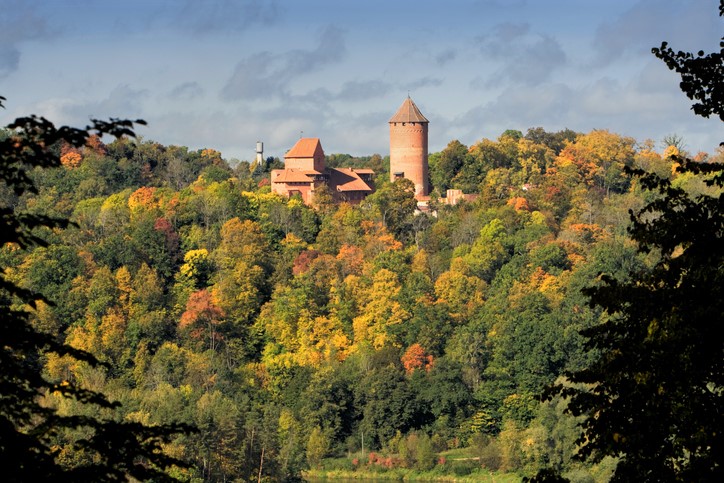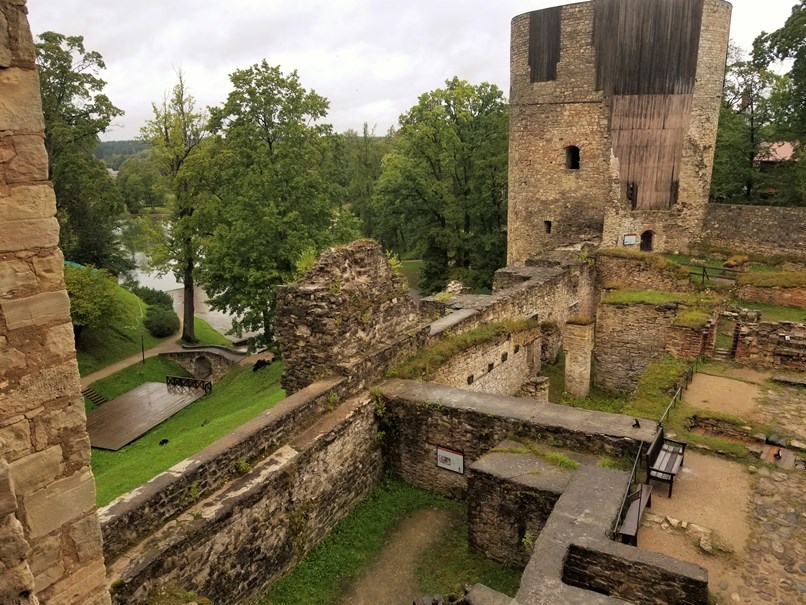Latvia – Into the Countryside
We set out in the pouring rain to explore the beautiful Latvian countryside. An hour drive from Riga, we reached the Gauja National Park, the largest National Park in Latvia, which runs 917 kilometers from north-east of Sigulda to south-west of Cēsis. The Gauja River flows through the verdant valley, making it a paradise for hiking, biking, bungee jumping, boating, rafting, bird watching, and horse riding. It’s a lush Garden of Eden, where villages and barns, ponds, ducks, little churches, and forests are scattered across the landscape.

Encased from head to toe in rain gear, we trudged through the horrid weather – umbrellas were useless as the winds turned them inside out, and I felt like Mary Poppins about to take off into the angry, gunmetal grey sky. Onwards we plowed hardy tourists determined not to let the weather deter us. A short hike through stunning parkland brought us to Gūtman’s Cave, reputed to be the largest and oldest erosion cave in the Baltics.

Tucked into a secluded corner of the park, Gutman’s Cave is famous for its inscriptions, which today we refer to as graffiti, that date back to the 17th Century and the sad love story legend of the ‘Rose of Turaida.’

One kilometer from Gūtman’s Cave, the red brick Turaida Castle with its cylindrical tower comes into view. Unfortunately, the stormy weather became so intense that we had to pass up a visit to the castle.

On to Cēsis – an adorable, medieval town with cobblestone streets.

We popped into a cozy café for cappuccino and delectable pastries before making our way to Cēsis castle, which was first built in the early 13th Century. It was partially destroyed several times over the centuries, but the excellent restoration work has preserved this medieval treasure without damaging its authenticity, and if you don’t visit any other castles (the area is dotted with castles), don’t miss this one, it’s a highlight.


After crossing the moat via a wooden walkway, we came across an elderly lady in traditional attire, who presented us with two lanterns with flickering candles.


With our dismally inadequate lanterns in hand, we entered a cave-like room with only a sliver of light. As we were about to take our leave, Stan ventured into a far corner and, with the aid of his flashlight, discovered a winding, steep, stone staircase that led us up to the next level which we assumed to have been a dining/living/kitchen space. The next dark staircase led us to a turret where we sat on wooden benches and were treated to an ongoing movie in-the-round, brilliantly and artistically conceived, which depicted the turbulent history of the castle. It was extraordinary, and well worth all the trudging through the rain and mud.



On the grounds, a short stroll from the medieval castle sits the manor house built in the 18th Century as a home belonging to the Von Wolff family and later purchased in 1777 by Count Eberhard Von Sievers. The Von Sievers family lived in the manor until the early 20th Century when it was taken from the family by the Latvian army. The manor house as one sees it today is the result of a restoration project which was undertaken in 2007 and lasted five years.
We only spent a day in the countryside, but in good weather, one could spend a couple of nights in Cēsis and take advantage of all that the area has to offer.
**Disclsure: Clearly, due to stormy weather, the photo of Turaida Castle was not taken by me.
